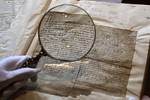 |
No matter how diligent you are, mistakes happen. And sometimes the mistakes are made by the IRS. Or possibly there’s just some additional information required. Whatever the case, you have received a letter or notice from the IRS. Scary stuff, right?? Maybe, but just receiving a letter from the IRS isn’t an immediate cause for alarm.
Just because you’ve received a letter from the IRS doesn’t mean you did something wrong. The IRS has been wrong before, and as mentioned above, there are lots of reasons that might cause them to send you a notice – not all of them are necessarily bad.
The IRS recently published their Tax Tip 2012-73, which lists “Eight Facts to Know if You Receive an IRS Letter or Notice”. The text of the Tip is below.
Eight Facts to Know if You Receive an IRS Letter or Notice
The IRS sends millions of letters and notices to taxpayers for a variety of reasons. Many of these letters and notices can be dealt with simply, without having to call or visit an IRS notice.
Here are eight things to know about IRS notices and letters.
- There are a number of reasons why the IRS might send you a notice. Notices may request payment, notify you of account changes, or request additional information. A notice normally covers a very specific issue about your account or tax return.
- Each letter and notice offers specific instructions on what action you need to take.
- If you receive a correction notice, you should review the correspondence and compare it with the information on your return.
- If you agree with the correction to your account, then usually no reply is necessary unless a payment is due or the notice directs otherwise.
- If you do not agree with the correction the IRS made, it is important to respond as requested. You should send a written explanation of why you disagree and include any documents and information you want the IRS to consider along with the bottom tear-off portion of the notice. Mail the information to the IRS address shown in the upper left of the notice. Allow at least 30 days for a response.
- Most correspondence can be handled without calling or visiting an IRS office. However, if you have questions, call the telephone number in the upper right of the notice. Have a copy of your tax return and the correspondence available when you call to help the IRS respond to your inquiry.
- It’s important to keep copies of any correspondence with your records.
- IRS notices and letters are sent by mail. The IRS does not correspond by email about taxpayer accounts or tax returns.
For more information about IRS notices and bills, see Publication 594, The IRS Collection Process. Information about penalties and interest is available in Publication 17, Your Federal Income Tax (For Individuals).




 Sterling Raskie, MSFS, CFP®, ChFC®
Sterling Raskie, MSFS, CFP®, ChFC® The latest in our Owner’s Manual series, A 401(k) Owner’s Manual, was published in January 2020 and is available on
The latest in our Owner’s Manual series, A 401(k) Owner’s Manual, was published in January 2020 and is available on  A Medicare Owner’s Manual, is updated with 2020 facts and figures. This manual is available on
A Medicare Owner’s Manual, is updated with 2020 facts and figures. This manual is available on  Social Security for the Suddenly Single can be found on Amazon at
Social Security for the Suddenly Single can be found on Amazon at  Sterling’s first book, Lose Weight Save Money, can be
Sterling’s first book, Lose Weight Save Money, can be  An IRA Owner’s Manual, 2nd Edition is available for purchase on Amazon. Click the link to choose the
An IRA Owner’s Manual, 2nd Edition is available for purchase on Amazon. Click the link to choose the  Jim’s book – A Social Security Owner’s Manual, is now available on Amazon. Click this link for the
Jim’s book – A Social Security Owner’s Manual, is now available on Amazon. Click this link for the  And if you’ve come here to learn about queuing waterfowl, I apologize for the confusion. You may want to discuss your question with Lester, my loyal watchduck and self-proclaimed “advisor’s advisor”.
And if you’ve come here to learn about queuing waterfowl, I apologize for the confusion. You may want to discuss your question with Lester, my loyal watchduck and self-proclaimed “advisor’s advisor”.